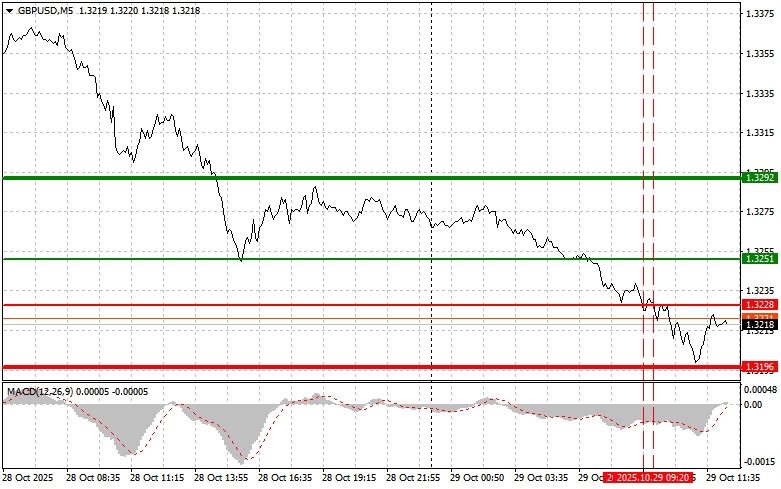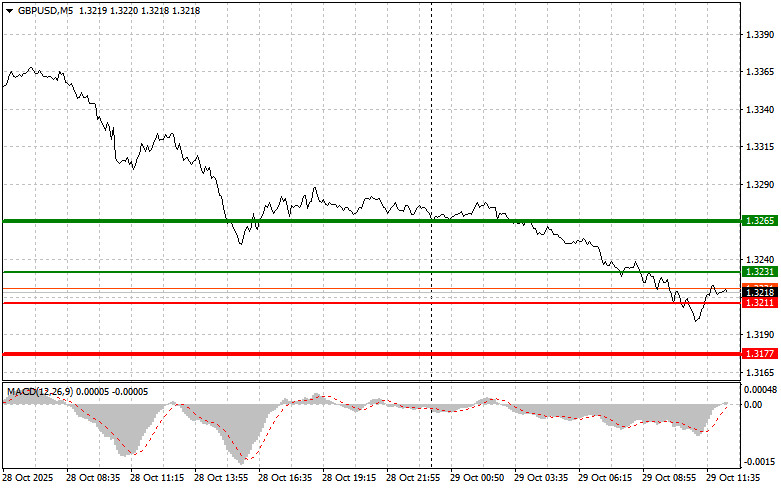Trade Analysis and Recommendations for the British Pound
The price test of 1.3228 occurred when the MACD indicator had already moved significantly below the zero line, which limited the pair's downward potential. The second test of 1.3228 triggered Scenario #2 for buying the pound, which resulted in losses as the pair continued to decline.
Only positive data on the growth in approved mortgage applications and changes in the M4 money supply in the UK managed to halt the bearish momentum for the pound. However, it's worth noting that the fundamental problems of the British economy have not disappeared. High inflation, political turmoil, and uncertainty about future trade relations with the EU continue to pressure the pound sterling. Any short-term correction could be used by bears to open new short positions at more favorable prices.
In addition, in the second half of the day, all attention will be focused on the FOMC's decision regarding the key interest rate, which is almost certain to be cut by a quarter of a point, as well as on the FOMC statement and Jerome Powell's press conference. If Powell expresses concern about the slowdown in economic growth and emphasizes the need for further monetary easing, this could weaken the U.S. dollar against the pound. In such a scenario, investors might shift their focus toward assets denominated in other currencies in search of higher returns.
As for intraday strategy, I'll focus mainly on implementing Scenarios #1 and #2.
Buy Signal
Scenario #1: Today, I plan to buy the pound when the price reaches around 1.3231 (green line on the chart), aiming for a rise to 1.3265 (thicker green line on the chart). Around 1.3265, I plan to exit buy positions and open short positions in the opposite direction, expecting a 30–35-point pullback. A strong rise in the pound today is possible only if the Fed adopts a very dovish stance.
Important! Before buying, make sure the MACD indicator is above the zero line and just starting to rise from it.
Scenario #2: I also plan to buy the pound if there are two consecutive tests of the 1.3211 level while the MACD is in the oversold zone. This will limit the pair's downward potential and lead to a market reversal upward. Growth toward the 1.3231 and 1.3265 levels can then be expected.
Sell Signal
Scenario #1: I plan to sell the pound after a breakout below 1.3211 (red line on the chart), which should lead to a quick decline in the pair. The target level for sellers will be 1.3177, where I plan to exit short positions and open long positions in the opposite direction, expecting a 20–25-point rebound. The pound may fall sharply only if the Fed takes a hawkish stance.
Important! Before selling, make sure the MACD indicator is below the zero line and just starting to move downward from it.
Scenario #2: I also plan to sell the pound if there are two consecutive tests of the 1.3231 level while the MACD is in the overbought zone. This will limit the pair's upward potential and lead to a market reversal downward. A decline toward 1.3211 and 1.3177 can then be expected.
Chart Explanation
- Thin green line – Entry price where buying the instrument is possible
- Thick green line – Suggested Take Profit level or a point to manually fix profits, as further growth above this level is unlikely
- Thin red line – Entry price where selling the instrument is possible
- Thick red line – Suggested Take Profit level or a point to manually fix profits, as further decline below this level is unlikely
- MACD indicator – When entering the market, rely on overbought and oversold zones
Important Notes for Beginner Forex Traders
New traders in the Forex market should be extremely cautious when deciding to enter trades. Before the release of major fundamental reports, it's best to stay out of the market to avoid sudden price swings.
If you decide to trade during news releases, always place stop-loss orders to minimize potential losses. Without stop-losses, you can quickly lose your entire deposit — especially if you ignore money management principles and trade with large volumes.
And remember: successful trading requires a clear trading plan, like the one presented above. Making spontaneous trading decisions based on short-term market movements is, by nature, a losing strategy for intraday traders.













